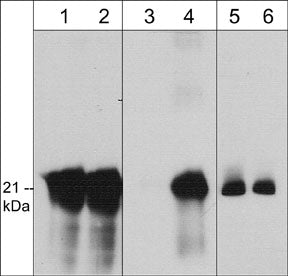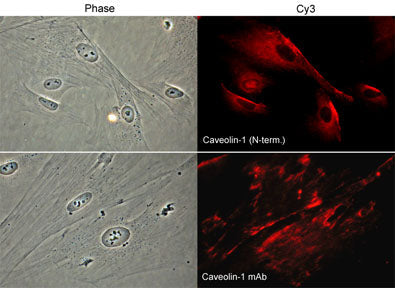Anti-Caveolin-1 (N-terminal region) Antibody
- SPECIFICATION
- CITATIONS
- PROTOCOLS
- BACKGROUND

Application
| WB |
|---|---|
| Primary Accession | Q03135 |
| Reactivity | Bovine, Chicken |
| Host | Rabbit |
| Clonality | Rabbit Polyclonal |
| Isotype | IgG |
| Calculated MW | 20472 Da |
| Gene ID | 857 |
|---|---|
| Other Names | caveolin1, vip21 |
| Target/Specificity | Caveolins are the primary structural components of the plasma membrane microdomains, caveolae. Three members of the caveolin family (caveolin-1, -2, and -3) have been identified, and each has distinct expression patterns. Caveolins are involved in diverse biological functions, including vesicular trafficking, cholesterol homeostasis, cell adhesion and apoptosis. Caveolins can interact with various signaling molecules, including G-proteins, receptor tyrosine kinases, PKCs, and Src family kinases. Phosphorylation at Tyr-14 is essential for caveolin association with SH2 or PTB domain-containing adaptor proteins, while phosphorylation at Ser-80 regulates caveolin binding to the ER membrane and entry into the secretory pathway. |
| Dilution | WB~~1:1000 |
| Format | Antigen Affinity Purified |
| Storage | Maintain refrigerated at 2-8°C for up to 6 months. For long term storage store at -20°C in small aliquots to prevent freeze-thaw cycles. |
| Precautions | Anti-Caveolin-1 (N-terminal region) Antibody is for research use only and not for use in diagnostic or therapeutic procedures. |
| Shipping | Blue Ice |

Thousands of laboratories across the world have published research that depended on the performance of antibodies from Abcepta to advance their research. Check out links to articles that cite our products in major peer-reviewed journals, organized by research category.
info@abcepta.com, and receive a free "I Love Antibodies" mug.
Provided below are standard protocols that you may find useful for product applications.
Background
Caveolins are the primary structural components of the plasma membrane microdomains, caveolae. Three members of the caveolin family (caveolin-1, -2, and -3) have been identified, and each has distinct expression patterns. Caveolins are involved in diverse biological functions, including vesicular trafficking, cholesterol homeostasis, cell adhesion and apoptosis. Caveolins can interact with various signaling molecules, including G-proteins, receptor tyrosine kinases, PKCs, and Src family kinases. Phosphorylation at Tyr-14 is essential for caveolin association with SH2 or PTB domain-containing adaptor proteins, while phosphorylation at Ser-80 regulates caveolin binding to the ER membrane and entry into the secretory pathway.
If you have used an Abcepta product and would like to share how it has performed, please click on the "Submit Review" button and provide the requested information. Our staff will examine and post your review and contact you if needed.
If you have any additional inquiries please email technical services at tech@abcepta.com.













 Foundational characteristics of cancer include proliferation, angiogenesis, migration, evasion of apoptosis, and cellular immortality. Find key markers for these cellular processes and antibodies to detect them.
Foundational characteristics of cancer include proliferation, angiogenesis, migration, evasion of apoptosis, and cellular immortality. Find key markers for these cellular processes and antibodies to detect them. The SUMOplot™ Analysis Program predicts and scores sumoylation sites in your protein. SUMOylation is a post-translational modification involved in various cellular processes, such as nuclear-cytosolic transport, transcriptional regulation, apoptosis, protein stability, response to stress, and progression through the cell cycle.
The SUMOplot™ Analysis Program predicts and scores sumoylation sites in your protein. SUMOylation is a post-translational modification involved in various cellular processes, such as nuclear-cytosolic transport, transcriptional regulation, apoptosis, protein stability, response to stress, and progression through the cell cycle. The Autophagy Receptor Motif Plotter predicts and scores autophagy receptor binding sites in your protein. Identifying proteins connected to this pathway is critical to understanding the role of autophagy in physiological as well as pathological processes such as development, differentiation, neurodegenerative diseases, stress, infection, and cancer.
The Autophagy Receptor Motif Plotter predicts and scores autophagy receptor binding sites in your protein. Identifying proteins connected to this pathway is critical to understanding the role of autophagy in physiological as well as pathological processes such as development, differentiation, neurodegenerative diseases, stress, infection, and cancer.



